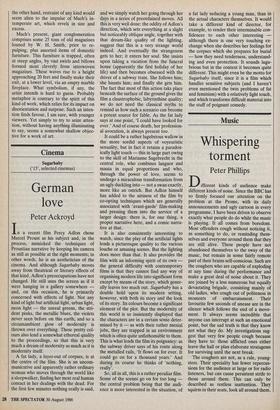Cinema
Sugarbaby (`15', selected cinemas)
German love
Peter Ackroyd
In a recent film Percy Adlon chose Marcel Proust as his subject and, in the process, mimicked the techniques of Proustian narrative by keeping his camera as still as possible at the right moments; in other words, he is an aesthetician of the cinema. And although Sugarbaby moves away from theatrical or literary effects of that kind, Adlon's preoccupations have not changed. He still uses the screen as if it were hanging in a gallery somewhere and, on this occasion, he is primarily concerned with effects of light. Not any kind of light but artificial light, urban light, neon light — the unreal greens, the stri- dent pinks, the metallic blues, the violets never seen before on this earth; and so a circumambient glow of modernity is thrown over everything. These pretty col- ours also lend a somewhat ethereal quality to the proceedings, so that this is very much a dream of modernity as much as it is modernity itself.
A fat lady, a layer-out of corpses, is at the centre of the film. She is an uncom- municative and apparently rather ordinary woman who moves through the world like a sleepwalker, finding her most real human contact in her dealings with the dead. For the first few minutes nothing really is said, and we simply watch her going through her days in a series of preordained moves. All this is very well done: the oddity of Adlon's direction, which sets everything at a slight but noticeably oblique angle, together with that dream-like quality of the lighting, suggest that this is a very strange world indeed. And eventually the strangeness gets to her; it enters her soul. She insists upon taking a vacation from the funeral home (apparently the first holiday of her life) and then becomes obsessed with the driver of a subway train. She follows him; she haunts him; and finally she gets him. The fact that most of this action taks place beneath the surface of the ground gives the film a claustrophobic, labyrinthine quality; we do not need the classical myths to remind us how such a scenario can become a potent source for fable. As the fat lady says at one point, 'I could have looked for ever.' And of course death, her profession- al avocation, is always present too.
It could be a rather lugubrious wallow in the more sordid aspects of voyeuristic sexuality, but in fact it retains a paradox- ically light touch — this in large part owing to the skill of Marianne Sagebrecht in the central role, who combines languor and mania in equal proportions and who, through the power of love, seems to undergo a miraculous transformation from an ugly duckling into not a swan exactly, more like an ostrich. But Adlon himself has added to the airiness of the film by co-opting techniques which are generally associated with 'avant-garde' film-making and pressing them into the service of a larger design: there is, for one thing, a proper narrative here, and a comic narra- tive at that.
It is also consistently interesting to watch, since the play of the artificial lights lends a picturesque quality to the various louche or amusing scenes. But the lighting does more than that. It also provides the film with an informing spirit of its own the general difficulty with contemporary films is that they cannot find any way of organising modern life into significant form except by means of the story, which gener- ally leaves too much out. Sugarbaby has a double hold upon its modern setting, however, with both its story and the look of its story. Its colours become a significant element of the plot. But the modernity of this world is so insistently displayed that the characters are in a certain sense deter- mined by it — as with their rather menial jobs, they are trapped in an environment which is often quite unfathomable to them. This is what lends the film its poignancy: as the subway driver says of his route along the metalled rails, 'It flows on for ever. It could go on for a thousand years.' And during its course he thinks of 'nothing, really'.
So, all in all, this is a rather peculiar film. Some of the scenes go on for too long the central problem being that the audi- ence is more interested in the situation, of a fat lady seducing a young man, than in the actual characters themselves. It would take a different kind of director, for example, to render their interminable con- fidences to each other interesting although there is one very touching ex- change when she describes her feelings for the corpses which she prepares for burial — how they need tenderness, understand- ing and even protection. It sounds lugu- brious but in the context it becomes quite different. This might even be the motto for Sugarbaby itself, since it is a film which handles sensitive subjects (and I haven't even mentioned the twin problems of fat and feminism) with a relatively light touch, and which transforms difficult material into the stuff of poignant comedy.








































 Previous page
Previous page